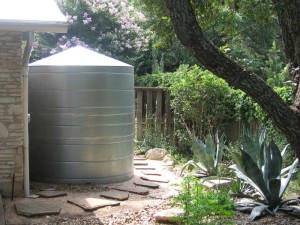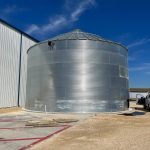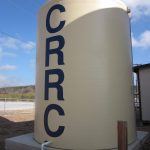 Rainwater harvesting is defined by Wikipedia as “the accumulation and deposition of rainwater for reuse on-site, rather than allowing it to run off.” While this definition is basic, the practice of rainwater harvesting is greatly varied from where the rainwater is collected from to how the rainwater is ultimately used.
Rainwater harvesting is defined by Wikipedia as “the accumulation and deposition of rainwater for reuse on-site, rather than allowing it to run off.” While this definition is basic, the practice of rainwater harvesting is greatly varied from where the rainwater is collected from to how the rainwater is ultimately used.
A more appropriate definition of rainwater harvesting might be the collection of rainwater from a surface that allows for the rainwater to be stored and used at a later time. In a typical rainwater harvesting situation, rainwater is collected from an impervious surface such as the roof of a building and then stored inside of a tank or cistern. Rainwater can be collected from other surfaces as well. Other surfaces include parking lots, roadways, driveways, and even land surfaces (once surface runoff from the land surface begins).
Rainwater can be harvested and stored for many uses including landscape irrigation, potable and nonpotable indoor use, and stormwater management. Harvested rainwater can be particularly useful when no other source of water supply is available, or if the available supply is inadequate or of poor quality.
Rainwater harvesting has benefits for both urban (where municipal water is available) and rural properties (where a water well is employed). The practice of rainwater harvesting ranges from simple ideas such as a rain barrel set up underneath a gutter downspout to complex systems such as for commercial buildings or systems that supply the potable water for a house.
The Semantics of Rainwater Harvesting
If you do an internet search for “rainwater harvesting”, you will probably see many other phrases come up in the search results. You might see the following:
- Rainwater collection
- Rainwater / Rain catchment
- Rainwater capture
- Water harvesting
- Water catchment
- Roofwater harvesting / collection
- Stormwater harvesting / collection
One major point of semantics is the difference (or similarity) of rainwater harvesting and stormwater harvesting. They really are one in the same but typically, “rainwater harvesting” is used to denote the capture of rainwater from a roof or other elevated surface while stormwater harvesting is the capture of rainwater that has hit a ground surface already. So while this is a major division in the practice of rainwater harvesting, it is also just subclasses of the overall definition of rainwater harvesting.
Another minor point of semantics in rainwater harvesting is the term “rainwater harvesting system”. A system denotes something more elaborate and complex. Therefore, a rain barrel is not a rainwater harvesting system. It is simply, a rain barrel.
Why Should I Harvest Rain?
Rainwater harvesting is becoming popular once again for two reasons: its superior water quality and a desire to reduce the use and dependence on municipally treated water for all of our daily uses. Rainwater has long been valued for its purity and softness. It is free from salts, minerals, and other natural and man-made contaminants. In addition, rainwater harvesting is valued as a water conservation tool since it allows you to use rainwater instead of municipally treated water. This, in turn, reduces the amount of water a municipality has to treat and deliver to their service area.
- Rainwater is essentially FREE; once the capital cost of the collection system infrastructure is paid for, you will harvest free water.
It is socially acceptable and environmentally responsible since it promotes self-sufficiency and helps conserve water. - It reduces your municipal water consumption and thus your water bill.
- It can be used as a main source of water or as a back-up source to wells and municipal water. It can also be very helpful in times of emergencies.
- It provides you with total control over your water supply (ideal for cities with water restrictions).
- Rainwater harvesting systems can be easily retrofitted to an existing structure or built during new home construction. They are very flexible and modular in nature, allowing expansion, reconfiguration, or relocation.
- Rainwater is the best water source for landscape irrigation due to the lack of chlorine and other treatment chemicals.
- Rainwater harvesting can reduce the frequency and intensity of flooding around your house or property.
- Since the use of the harvested water is located close to the collection source, this reduces the energy use required to move water around our cities.
- Rainwater harvesting can reduce stormwater pollution, lessening its impact on our local watersheds.
One HUGE Benefit of Rainwater Harvesting
We believe one of the biggest benefits of harvesting rainwater to replace the use of water from a municipal water supply or water well, is the ability to examine your relationship with water. In industrialized nations, we take our water supply for granted. We can turn on a faucet and relatively clean water comes out. We turn off the faucet and then walk away, not thinking about all of the steps and processes it took to get that clean, potable water to your faucet.
Harvesting and using rainwater will allow you to start to understand the sheer quantity of water that you use daily for specific purposes. If you are using the harvested rainwater for irrigation purposes, you will start to realize just how much water your landscaping requires, rather than just relying on an automatic sprinkler system that comes on a few times a week to water your landscaping. From this knowledge, you can start the discussion of potentially converting your landscaping to more native plants that are adapted to your local area or potentially changing some of the landscaping areas to areas that don’t require water. This can include changing turf areas to areas of plants or shrubs or changing areas to more xeriscape areas.
The founders of IWS had the opportunity to serve in the US Peace Corps in Suriname, South America. While stationed there, we relied on rainwater harvesting systems for all of our drinking and cooking water supply. During the wet season, there would be enough rainfall so we could perform some bathing and dish/clothes washing with the collected rainwater. During the dry season, it was another story. In order to preserve our harvested rainwater for the important uses of drinking and cooking, we would use the local river to wash our dishes, clothes, and ourselves. When you have to walk ½ a mile to the river to wash your dishes, clothes, and yourself, you soon start to appreciate the ability to turn on a faucet and have clean, potable water come out of it.
Rainwater Harvesting System Design
In terms of system design, these systems can be implemented without much thought or they can employ feasibility studies that take into account many different factors for the site.
If you want to harvest rainwater just to use it to water your patio plants, then you don’t have to think about the design of the system much. A simple rain barrel will work for this situation.
Deciding to install a complex system may require you to take into account many site factors, such as:
- Local rainfall quantities and pattern
- Roof area availability
- Storage volume options
- Water demand calculations
- Other information, as necessary
Taking these factors into account will allow you to design and craft a rainwater harvesting system that will be efficient and effective for accomplishing the goals of the system.
Rainwater Harvesting System Components
Typically, a rainwater harvesting “system” is thought of to contain 4 distinct parts:
- Collection surface or catchment area
- Conveyance system
- Storage volume
- Distribution system
In each of these parts, there are a variety of methods, materials, and technical issues that can allow the system to be individualized for the particular site. These parts will be discussed further in individual FAQ posts.
Conclusion
Rainwater harvesting is an ancient practice that stills holds many benefits and value for our modern times. It provides an alternative water source while allowing you to control and operate the system as you see fit. Rainwater collection can also teach valuable lessons in water conservation which is becoming more important as our freshwater resources get stretched further and further.





